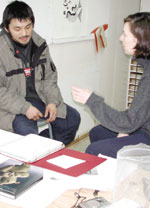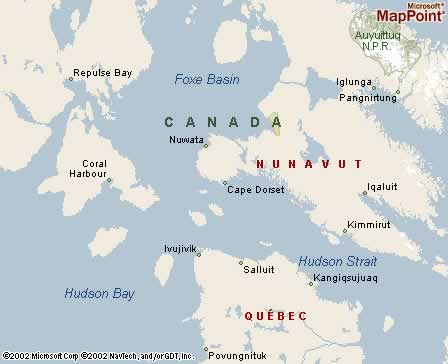|
|
Canku Ota |
|
|
(Many Paths) |
||
|
An Online Newsletter Celebrating Native America |
||
|
March 20, 2004 - Issue 109 |
||
|
|
||
|
New Generation Pushes Boundaries of Inuit Art |
||
|
by Greg Younger-Lewis - Nunatsiaq
News
|
||
|
credits: Christine
Lalonde, acting associate curator for Inuit art at the National
Gallery of Canada, met recently with Isaacie Etidloi in Cape Dorset
to discuss an upcoming cross-Canada tour of his work. (Photo by
Greg Younger-Lewis)
|
|
High-profile national exhibit shows carvers' bold new visions
But shortly after "watching, but not listening to" his father, Etidloi found some advice he could follow, which he credits with setting the course of his career, soon to be boosted by a cross-Canada tour of his work. The advice came when an uncle looked over his work and said to do something different. "He said you should do something that catches the eye," Etidloi, now 31, recalled in an interview. Etidloi said his uncle's words steered him away from traditional animal themes, made famous by his father's generation, and inspired him to sculpt people - a decision that now lands him in the national spotlight. Along with the carvings of fellow artists from Nunavut and beyond, Etidloi's work will travel through all major cities across Canada in a high-profile exhibition organized by the National Gallery of Canada. The show, which includes 25 stone carvings made since 1990, is billed as a journey into the heart of contemporary Inuit art. Christine Lalonde, acting associate curator for the gallery's Inuit art collection, sat down with Etidloi in Cape Dorset this month to iron out details about how his carving of a drum dancing shaman will be displayed. Lalonde said Etidloi's penchant for breaking with tradition made him an ideal candidate for the exhibit. The show comes as part of the national gallery's mandate to show its collection to the whole country, not just Ottawa, where the gallery is located. Also, Inuit art is changing, Lalonde said, and it's the national gallery's job to keep up with the trends. Advertisements for the tour suggest the exhibit will show that "contemporary" no longer refers to the art produced by Inuit after contact with Southerners. The term will now refer to art made closer to the new millennium. "This group ... caught people's attention because it's doing something different," Lalonde said of the artists selected for the exhibit. "It [their work] encourages others to follow their own path." Besides seeing a shift in subject matter, Lalonde said many Inuit carvers now experiment with different media, going beyond soapstone with works of limestone, silver, ebony or copper. Some were made by "serendipitous" ways, like Oviloo Tunnillie's "Skier," which originally had the full shape of a person skiing but accidently broke at the waist. Intrigued by contrast of the raw, rough scar on top of the smooth, shiny torso and legs, the artist sold the half-piece as a whole, introducing a new look to Inuit sculpture, Lalonde said. Toonoo Sharky, another Cape Dorset artist showcased in the exhibit, said the new look in Inuit art comes from access to new technology. The 33-year-old artist said his grandfather, who inspired him to start carving, would only have access to manual tools, instead of the electric drills and sanders used today. Beyond technology, the change in Inuit art comes naturally, said Sharky, who has carved out a name for himself by mixing subjects such as human faces with the feet of seal. "I do that because the art buyers, they want to see different things," he said. "I do it to make it more interesting." Beside the economic incentive, Sharky said, he'd be bored if he did the same as everyone else. Along with the other chosen sculptures, Sharky's carving "The Legend of the Blind Boy" will be on the road with the exhibit for about two years beginning September. |
|
|
www.expedia.com |
|
|
||
|
|
||
| Canku Ota is a free Newsletter celebrating Native America, its traditions and accomplishments . We do not provide subscriber or visitor names to anyone. Some articles presented in Canku Ota may contain copyright material. We have received appropriate permissions for republishing any articles. Material appearing here is distributed without profit or monetary gain to those who have expressed an interest. This is in accordance with Title 17 U.S.C. Section 107. | ||
|
Canku Ota is a copyright © 2000, 2001, 2002, 2003, 2004 of Vicki Lockard and Paul Barry. |
||
 |
 |
|
|
The "Canku Ota - A Newsletter Celebrating Native America" web site and its design is the |
||
|
Copyright © 1999, 2000, 2001, 2002, 2003, 2004 of Paul C. Barry. |
||
|
All Rights Reserved. |
||
 CAPE
DORSET - More than two decades ago, Isaacie Etidloi had the habit
of watching his father skillfully transform blocks of rock into
loons outside their house in Cape Dorset. Then, against his dad's
wishes, seven-year-old Etidloi would grab some rock and tools and
aim to do the same. The rebellion was allowed, and Etidloi became
a carver.
CAPE
DORSET - More than two decades ago, Isaacie Etidloi had the habit
of watching his father skillfully transform blocks of rock into
loons outside their house in Cape Dorset. Then, against his dad's
wishes, seven-year-old Etidloi would grab some rock and tools and
aim to do the same. The rebellion was allowed, and Etidloi became
a carver.